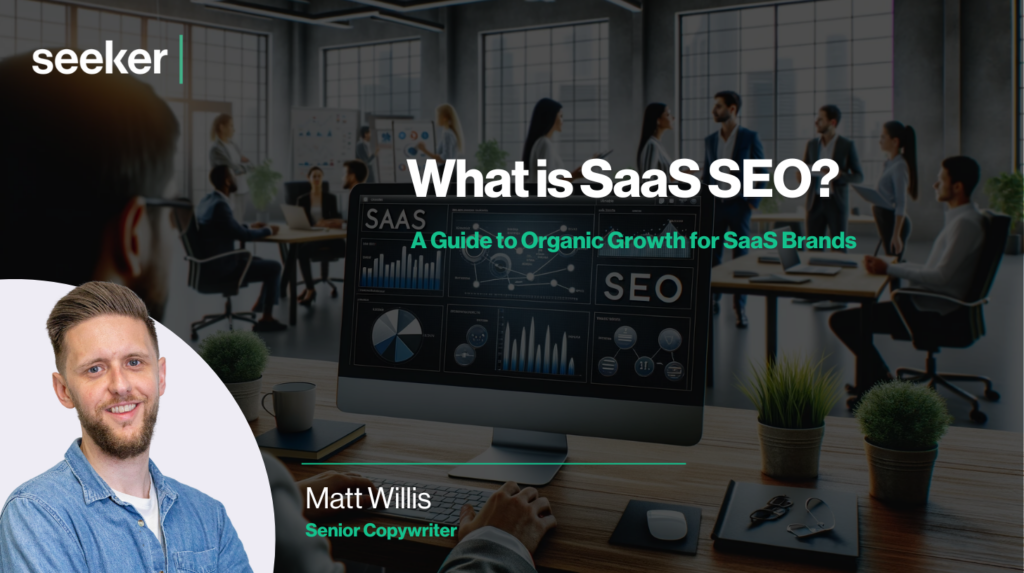
The term ‘SaaS SEO’ might be something of a miniature tongue-twister (that’s a lot of S’s for one industry-merging catchphrase), but when it comes to Software-as-a-Service, a robust SEO strategy is pretty much non-negotiable.
The SaaS industry is currently valued at just shy of $260 billion — experiencing over 300% growth in the past eight years — so it would be a colossal understatement to describe it as a competitive sector. In fact, there are thought to be close to 31,000 SaaS companies operating across the globe as of 2023.
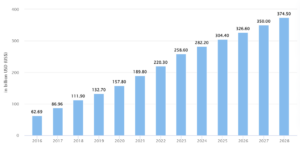
Projected growth of the SaaS industry: Statista
To stand out in this increasingly congested market, SaaS brands can’t simply rely on passive marketing initiatives — instead, they need to be proactive, cultivating their brand image, driving visibility and awareness, and establishing industry authority in order to future-proof their growth.
This is why SEO is so paramount for SaaS brands (and we should know, having worked successfully with many over the years); it enables them to target precisely the right audience, generate long-term traffic gains, foster trust and credibility, and crucially, score a competitive edge in the marketplace.
In this deep dive into all things SEO and SaaS, we explain how SaaS brands can elevate their organic growth through a successful SaaS SEO strategy.
Ready? Let’s put our foot on the SaaS.
What is SaaS SEO?
Put simply, SaaS SEO is a specific approach to search engine optimisation that focuses on the unique needs and challenges of a SaaS business. Like traditional SEO, driving organic traffic for a SaaS brand involves a combination of factors, including optimising on-page content for relevant keywords that drive search volume, engaging in value-driven content marketing, and building high-quality SaaS backlinks to cement brand authority.
Unlike traditional SEO, however, SaaS SEO typically targets more specific, niche keywords that are highly targeted towards software solutions, and focuses on content that addresses the particular needs of SaaS customers — feature explanations or case studies, for example. The goal of SEO for SaaS is ultimately to attract the type of high-quality, qualified traffic that converts into paying users and subscribers.
Did you know…
- 71% of B2B customers begin their online research with a search engine.
- SEO-generated SaaS leads have a closure rate of 14.6%, compared to 1.7% for outbound leads.
- SEO for SaaS has an average ROI of 702%, with a 7-month time to break-even.
- SaaS companies that use content marketing experience a 30% higher growth rate than those that don’t.

Image: Pexels
What’s different about a SaaS SEO Strategy?
Isn’t a SaaS SEO strategy just the same as any other SEO strategy? You might think so, and in some ways, you’d be right, but there are several unique challenges and characteristics that mean SaaS companies often have to approach SEO a little differently.
For one thing, a SaaS SEO strategy is often more content-heavy, focusing on education and long-term customer engagement, and placing a strong emphasis on the technical aspects of the product. For SaaS companies, SEO is not just about driving traffic, but attracting the right audience, nurturing them through an often protracted sales cycle, and maintaining their engagement post-purchase.
Here are a few specific examples of why a SaaS SEO strategy often requires a more targeted approach:
Niche target audiences and intent
The target audience for SaaS products is typically more niche and narrow than other industries. SaaS customers are often seeking significant efficiency improvements or specific solutions to business problems, and this means that keywords and content need to be tailored to address these explicit needs and pain points, often involving more technical, industry-distinct language.
A need for educational and value-driven content
Because of the nature of SaaS products, a higher level of customer education is often a prerequisite. Prospective customers may need to understand the technical aspects of the software — its integration capabilities and how it addresses their specific issues, for instance. Therefore, a content marketing strategy in SaaS SEO often focuses heavily on educational content, guides, tutorials, and case studies.
Extended and complicated sales cycles
Unlike many day-to-day products and services, SaaS typically comes with a longer — and often more complex — sales cycle. Because they’re often targeted at businesses, the decision to purchase or subscribe to a SaaS product often involves multiple stakeholders and a protracted consideration period. An SEO strategy, therefore, needs to cater to every stage of the buyer’s journey, from awareness and education to consideration and final decision.
The importance of clear CTAs
The primary goal of a SaaS website is to convert visitors into leads or customers. Calls-to-action (CTAs) are the tools that prompt these conversions — whether that involves signing up for a free trial, scheduling a demo, or subscribing to a service — and reduce the decision-making load on the user. Without clear CTAs, even high-quality content or keyword-optimised pages can fail to convert visitors into customers.
A focus on customer retention
Rather than encouraging one-off purchases, SaaS companies typically aim to forge long-term customer relationships, so there’s an acute focus on driving customer retention and minimising churn. SaaS SEO strategies, therefore, often focus on delivering long-term value and support, and may call for a wealth of resources for existing customers as well as prospective ones.
A competitive landscape
As we’ve covered, the SaaS market is relentlessly competitive, with myriad brands offering comparable or like-for-like solutions. This dog-eat-dog landscape often demands a more aggressive and innovative SEO strategy to appeal to search engines and stand out among hordes of competitors. This might involve targeting niche long-tail keywords, creating more in-depth content, or becoming early adopters of emerging SEO trends.
Why is SEO important for SaaS companies?
SEO is important for any business with a digital presence, of course, but it’s an especially essential pillar in the digital marketing strategy of a SaaS brand. A SaaS company often has singular objectives and a very specific target audience, and SEO can be a key differentiator in a uniquely competitive sector.
Let’s delve into some of the reasons SaaS SEO is so important:
SEO is typically more cost-effective than other marketing channels
Compared with traditional advertising, SEO is often a more economical way to reach a target audience. While it naturally requires an up-front financial commitment in terms of time and resources, the long-term benefits of consistent traffic and lead generation make SaaS SEO a worthwhile endeavour that can generate a significant return on investment.
The typical return on advertising spend (ROAS) for SaaS SEO is 8.75 (this means for every dollar spent on SEO, you’ll generate $8.75 in gross revenue).
Paid ads stop generating returns as soon as a campaign ends, but that’s not the case for SEO. Sure, it requires consistency, persistence, and adaptability, but once a SaaS brand ranks well for certain keywords it can continue to attract traffic without the need for high-level spending, while good quality, evergreen content attracts and engages potential customers for years to come.
SEO is crucial for building visibility and brand awareness
Visibility and awareness are hard to come by in an industry so abundant with competing products and services, and that’s precisely why they’re such valuable commodities. For any SaaS company, being visible among search engine results pages (SERPs) is the most unequivocal and straightforward goal of a SaaS SEO strategy.
SaaS SEO positions a brand where potential customers are actively searching for solutions. By ranking in search results for relevant keywords, a SaaS brand increases its chances of being discovered by users who may not have been aware of its existence — in a crowded SaaS market, this exposure is critical.
Moreover, brand positioning for SaaS brands defines how they differentiate themselves in this competitive sector. Through industry-leading content marketing and a dynamic digital PR strategy, SaaS SEO can help cultivate the brand’s unique value proposition, aligning it with the individual needs of SaaS consumers.
SEO helps SaaS brands to establish E-E-A-T
A key basis of any successful SaaS SEO strategy is E-E-A-T, a Google guiding principle that stands for experience, expertise, authoritativeness, and trustworthiness, and is considered by the search engine as a key indicator of the quality of search results. When assessing web content in terms of its E-E-A-T credentials (the ‘E’ for ‘experience’ was a relatively recent new addition), Google will evaluate the following:
- Does the site’s content convey first-hand experience of the subject matter? Is it written by someone who’s been there and done it?
- Has the content been created by someone who is an expert in their particular field?
- Does the content project industry-specific authority? Does it include citations from authoritative sources and backlinks from trusted sites, for example?
- Can the content be trusted? Is it reliable, transparent, and factually accurate?
For SaaS websites, appealing to this four-pillared ranking factor is pivotal, since the often technical nature of the products demands a high level of user trust. There’s something of a snowball effect at play here, in that whilst increasing authority in the eyes of search engines will help to boost search engine rankings, appearing high in the SERPs reciprocally signals to users that the brand is likely to be credible and trustworthy. Win-win.
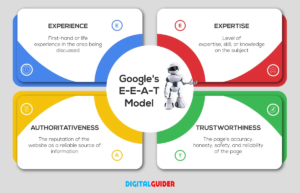
Image: Digital Guider
SEO allows SaaS companies to target the right audiences
Rather than simply attempting to rank for high-volume yet broad keywords that are likely to be prohibitively competitive, SaaS SEO enables your SaaS brand to hone in on the specifics of your product and your intended audience.
Through a tailored and targeted keyword strategy, SEO allows SaaS businesses to target niche, longer-tail keywords that potential customers are likely to use when searching for a SaaS product to meet their unique needs — focusing very much on specificity and search intent.
Perhaps your software is expressly designed for startup businesses due to its entry-level simplicity and non-restrictive pricing, or maybe it’s focused on specific industries like hospitality. Either way, a SaaS SEO strategy helps you uncover opportunities to rank for very targeted searches that closely match intent to the product you’re offering.
Whilst these niche keywords (‘payroll software for hospitality businesses’, for instance) will not drive anywhere near the same search volume as more general industry terms, their more targeted nature means they’ll attract qualified traffic — users with a genuine interest in your product and a high level of purchase intent — which in turn will drive more high-quality leads and conversions.
SEO can generate long-term traffic growth
Unlike paid advertising, which only generates traffic and leads for as long as you’re willing to pay for it, SaaS SEO can lead to sustained traffic growth over time. Of course, this doesn’t mean you can simply launch a strategy and watch your organic search traffic soar — your SEO efforts require persistent attention and analysis — but by cultivating and evolving your brand organically, you can reap the benefits over a consistent period.
By gradually enhancing online visibility and credibility through keyword optimisation, targeted content marketing, and high-quality backlink building, SaaS companies can build a continually lucrative organic growth model. These combined SaaS SEO efforts not only boost short-term visibility but also help establish the kind of sustained, scalable online presence essential for competitiveness in the SaaS market.
SEO offers data-driven insights
Data is invaluable for SaaS companies, providing deep insights into user behaviour, market trends, and consumer demand, and enabling brands to tailor their products, services, and marketing strategies to meet evolving needs.
While data can be gleaned from a number of places, SaaS SEO provides a goldmine of actionable insights. By leveraging search data from a tool such as Ahrefs, for example, SaaS brands can tap into emerging search trends, monitor what keywords their competitors are ranking for, and identify content and keyword gaps.
These insights can then be leveraged to build a robust, industry-relevant content plan.
Is AI the future of SaaS SEO?
It’s undeniable that artificial intelligence (AI) is having a transformative impact on the SaaS and SEO industries in general — and pretty much every global industry, for that matter — but is it also changing the way we approach SaaS SEO? Here at Seeker, we’re advocates of the efficiency-boosting power of automation, and we believe this swiftly-evolving technology has the power to level up your growth strategy if leveraged strategically.
When it comes to SaaS SEO strategies specifically, optimising your SaaS brand for AI-powered searches will become increasingly essential, for a number of reasons:
- The evolution of search experiences. AI-powered chatbots such as ChatGPT and Bard are transforming the search landscape for SaaS consumers. Allowing for natural, conversational queries, they combine information from multiple sources into clear, concise responses.
- Enhancements in search algorithms. AI technologies like Google’s RankBrain have evolved search engine algorithms to better understand and interpret user intent. SaaS brands therefore need to focus on creating content that genuinely addresses user needs and queries, rather than merely optimising for keywords.
- The rise in AI-powered voice search. AI-powered voice assistants are making voice search increasingly commonplace. SaaS content that is optimised for AI is more likely to be picked up in voice searches, which often have different requirements compared to traditional text-based searches.
- The need to stay ahead of technological trends. The digital landscape is rapidly evolving, with AI playing a leading role in that evolution. SaaS brands that embrace automation and machine learning are better positioned to adapt to and leverage new technologies, maintaining a competitive edge.
- An ability to leverage predictive analytics and insights. AI will enable SaaS brands to utilise predictive analytics to anticipate future trends and user needs, allowing for more proactive and strategic content creation and planning in future
How to grow organic traffic through SaaS SEO
1. Conduct thorough keyword research
Keyword research is the cornerstone of any solid SEO strategy, and it’s particularly imperative within the highly-competitive SaaS space. By identifying relevant, industry-defining keywords and optimising your onsite content with those keywords in mind, you increase your ranking potential and your ability to attract qualified, highly-engaged organic traffic.
We’ve built keyword strategies for many successful SaaS SEO campaigns, and here are our experience-led tips for SaaS keyword research:
- Understand your audience and their intent. Identify relevant keywords by understanding the problems your target audience is trying to solve, and also the stage of the buying journey they may be at. Focus on keywords that are relevant to your audience — features, benefits, or issues that your software solves, for example.
- Analyse your competitors. Using tools such as SEMrush, Ahrefs, or Google Keyword Planner, examine the keywords your direct competitors are already ranking for. You can then target the same keywords through superior content, or attempt to rank for potentially valuable keywords they may be overlooking.
- Target long-tail keywords. Long-tail keywords (very specific, multi-word phrases) typically have less search volume but crucially less competition. Since they tend to align closely with user intent, targeting long-tail keywords often leads to better quality leads and higher conversion rates.
- Monitor search trends. The SaaS industry is perennially evolving, and search engines are continuously refining their algorithms, so it’s important to keep abreast of search trends using tools such as Google Trends. By doing this, you can adapt your strategy to capitalise on emerging keywords and phrases.
- Prioritise keywords by relevance and difficulty. Using a tool such as SEMrush’s Keyword Magic Tool, rank your target keywords based on relevance to your product and how difficult they are to rank for. Ideally, you should aim for a combination of competitive keywords and highly-relevant low-moderate difficulty keywords.
- Monitor and refine your keyword strategy. Use analytics to understand the impact of your keyword strategy on traffic and conversions, and regularly track your rankings for your target keywords using a tool such as Google Search Console. Be prepared to refine and update your strategy based on these performance insights.
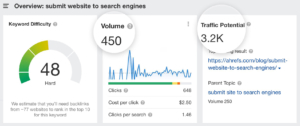
Image: Ahrefs
2. Optimise for the different stages of the SaaS buyer journey
In SaaS, arguably more so than in many other industries, the buyer journey is critical. As mentioned above, the SaaS buyer journey is typically quite complex and protracted due to a number of stakeholders often being involved in the consideration and decision-making processes. Understanding the nuances of this journey is vital because it means you can create and optimise your content to target users at each and every stage.
This is where intent is paramount. When a user enters a keyword into a search engine, they’ll often have a very specific purpose. For example, their intent may be purely informational (gaining knowledge of a particular topic), navigational (looking for a specific brand or web page), commercial (investigating products or buying options), or transactional (ready to complete an action or make a purchase).
Throughout the stages of the SaaS buying process, a user’s search query may indicate a number of different intentions — they may be at the awareness stage, for instance, which might involve researching solutions to a business problem, or they may have progressed to the consideration phase, comparing and evaluating different options. If they’ve moved to the decision stage, they’re ready to make a commitment to a particular product.
When creating and optimising content, it’s important to understand this intent. For example, a user at the awareness stage may just be looking for information — and so keywords such as “how to [solve problem X]” are likely to be key — while someone at the consideration stage might be comparing two or more products (e.g. “product X vs product Y”). Ensure you create a range of content that addresses each of these buying stages and search intents.
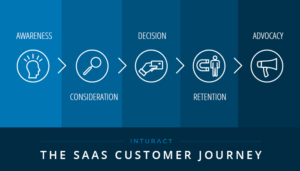
Image: Inturact
3. Create content that addresses your audience’s needs
For any SaaS brand, a successful SEO strategy is highly dependent on the quality of its content strategy. When it comes to content creation and optimisation, the aim is to address your target audience’s specific needs, preferences, and pain points.
Educational content is often highly valuable to SaaS customers since the products and services offered by SaaS businesses may require a degree of technical understanding, but the key is to create content that addresses a diverse range of needs, targets users at different stages of the buying journey, and showcases your expertise in a variety of different formats.
For example, a SaaS content strategy might include:
- Educational blog posts. Blogging about SaaS products is a skill in itself, but by addressing common challenges and questions related to your industry in your blog content, you can position yourself as a thought leader while also increasing your brand’s ability to rank for a greater number of related keywords.
- Landing pages. Each of your products or services should have dedicated landing pages to attract qualified traffic. Product pages and feature pages should be optimised for search engines, of course, but they should be created with users in mind first, considering search intent and showcasing tangible benefits.
- Whitepapers and e-books. In-depth guides or reports on specific industry topics can be highly-effective authority-building tools — displaying your brand’s extensive knowledge of its niche — but are also great for lead generation, as they can be offered in exchange for contact information.
- Webinars and online workshops. Hosting live or pre-recorded webinars can educate your audience about your product or industry trends. It’s an effective way to engage with potential customers and gather leads while also driving home your brand’s expertise within the SaaS industry, increasing trust and authority.
- Tutorials and demos. For leads at the consideration or decision-making stages of the buyer journey, product tutorials and demos can be highly valuable. Use them to convey the key features and benefits of your product, highlighting its ease-of-use and problem-solving capabilities.
- Infographics. Infographics are not only visually engaging, but they can simplify complex concepts or sets of data related to your industry. Because they’re easily shareable, they’re great for generating inbound links and outreaching as part of your digital PR strategy.
- Data studies. Conducting a study — whether it’s a consumer survey or a market report — can help position your SaaS brand as an industry leader with its finger on the pulse. This can also attract links from journalists or influencers who want to share the findings with their audiences.
- Podcasts. Podcasts provide a great way to help you reach new audiences and build a community around your brand. A podcast series discussing industry-specific topics can even generate organic traffic, with Google able to incorporate podcast topics and keywords into its ranking algorithm.
- Social media posts. Social media is often a hotbed of SaaS-related activity, so it’s important to regularly post relevant, engaging content to increase brand visibility and drive traffic to your website. It’s also a great way to connect with leads on a more personal level, lending your brand authenticity and personality.
4. Build links from credible, authoritative sources
Whilst internal links are important for SaaS SEO (since they help search engine bots find, index, and understand each web page on your site), it’s equally essential to build a healthy number of links from relevant external sources. Google has played down the importance of backlinks in recent years, but nonetheless, generating high-quality links at scale remains one of the most effective ways of building brand authority and increasing rankability.
There are a number of ways for a SaaS brand to build backlinks as part of an overall SEO process. Just some of these include:
- Guest blogging. Posting guest blog content on other sites is one of the oldest link building tactics in the book, but it remains effective so long as you’re targeting reputable, relevant sites in your outreach strategy. Avoid private blog networks (PBNs) or link farms, sites that exist solely to provide backlinks and artificially improve search rankings.
- Digital PR. The ultimate goal of digital PR is to gain valuable links — therefore increasing a brand’s visibility, awareness, and reputation — by securing coverage in relevant, high-traffic online publications. PR opportunities can come in the form of press releases, in-depth analysis, thought-leadership content, expert commentary, or digital assets, and involve strategic, targeted outreach.
- Broken link building. This technique involves identifying broken external links (which point to ‘dead’ or non-existent pages) on other websites and suggesting to replace them with a link to your own site. It’s something of a win-win for both parties, since you secure a new backlink and the site owner gets to revive a previously redundant link.
- The ‘Skyscraper Technique’. This is a link building practice whereby you identify the top-performing content in your niche (with a high number of existing backlinks) and create your own superior version. You can then reach out to those linking to the original content and recommend that they link to yours instead — since it’s theoretically a better or more comprehensive alternative.
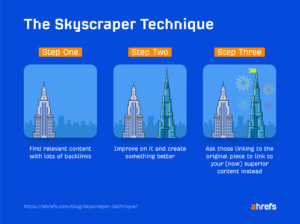
Image: Ahrefs
It’s important to remember that not all backlinks are created equal, however. When evaluating the quality of each backlink, search engines will consider a number of factors, including the site’s domain rating or DR (which measures the strength of its backlink profile), the relevance of the content to the link, and the makeup of the anchor text (the clickable text that includes your link).
For SaaS, the goal is to build a backlink profile that is rich and diverse, encompassing links from a number of different sources (from high-traffic websites with established industry authority to smaller but hyper-relevant sites) and avoiding low-quality, irrelevant, or obviously ‘spammy’ sites. It’s also a good idea to mix up your anchor text strategy, combining branded, generic, exact-match, and long-tail phrases.
5. Don’t overlook the technical fundamentals
In SaaS, technical SEO strategies are just as important as on-page SEO or offsite tactics such as content optimisation and external link building. Technical SEO is essentially the foundation of an SEO campaign or strategy — and without a strong foundation, even the most marketing-savvy SEO brand is unlikely to drive significant traffic or visibility.
In the first instance, page performance and load speeds are paramount, since they’re fundamental principles of Google’s Core Web Vitals, a set of key ranking factors that measure content loading times and page stability. Tools like Google’s PageSpeed Insights can help identify bottlenecks and areas for improvement, but it’s important to optimise onsite images, minify CSS and JavaScript files, and leverage browser caching to minimise lag.
It’s equally important, meanwhile, to ensure your website has a logical structure, with a clear hierarchy and easily navigable menus. Building and regularly updating an XML sitemap can enhance crawling and indexing, while using breadcrumb navigation and a well-structured URL format means search engines and users can seamlessly navigate your content.
However, there are also a number of additional technical SEO factors to consider. For example:
- Use HTTPs to secure your website
- Use the robots.txt file to tell search engines what to crawl
- Implement schema markup to help search engines understand your content
- Ensure your site is responsive and provides a good mobile experience
- Optimise on-page elements such as title tags, meta descriptions, and headers
- Identify and fix broken links (404 errors) and improper redirects (301/302)
- Avoid duplicating content and use canonical tags where necessary
- If required for international SEO, implement “hreflang” tags for language and regional targeting
6. Track, analyse, refine; then do it again
In the ever-evolving world of SaaS, a static SEO strategy is a recipe for stagnation. The importance of continuously tracking, analysing, and adapting your SEO strategy cannot be overstated — it’s the key to staying ahead of the curve in a fiercely competitive market.
Google and other search engines regularly update their algorithms, so what works today may not work tomorrow. Keeping abreast of these changes (such as the September 2023 rollout of the Helpful Content Update), measuring their impact on your performance, and adjusting your strategy accordingly is essential if you want to maintain rankings.
Moreover, user preferences and market trends are in a state of constant flux — the aforementioned AI revolution is changing user search behaviour significantly, for example. Again, by continuously monitoring these changes — using a tool such as Google Trends — you can tweak your content and keyword strategies to remain relevant and keep attracting the right audience.
It’s also vital to remember that your competitors are not static, either. They are likely optimising and refining their strategies just like you. Regular analysis of competitor activity — monitoring what keywords they’re ranking for and where they’re generating backlinks from, for example — allows you to stay competitive and leverage opportunities your competitors might be overlooking.
Here are some of our tried-and-tested strategies for performing consistent monitoring and analysis of your SaaS SEO strategy:
- Leverage analytics tools. Tools like Google Analytics and Google Search Console provide invaluable insights into website performance, user behaviour, and traffic sources. Regularly reviewing this data helps identify what’s working and what needs tweaking.
- Monitor keyword performance. Keep track of how your keywords are performing. Shifts in rankings can signal the need for content updates or new keyword targeting, for example.
- Assess content relevance and quality. Continuously evaluate and update your content strategy. Tools like Surfer SEO can audit your existing content and make recommendations for optimisation.
- Conduct technical SEO audits. Regular site audits can uncover issues like slow page load times, broken links, or crawl errors, which can significantly impact your SEO performance if left unaddressed.
- Stay updated on SEO best practices. The SEO world is dynamic. Stay informed about the latest trends and best practices in SEO for SaaS businesses by following industry leaders on social media, subscribing to relevant newsletters, or attending webinars or conferences.
Wrapping up this deep dive into SaaS SEO, remember that the journey to optimal online visibility is not a one-time effort, but a continuous process of evolution and adaptation. As a SaaS brand, your goal is to not just reach your audience but to resonate with them, and this requires a keen understanding of SEO dynamics.
From meticulously researching keywords to crafting user-centric content and staying agile with ever-changing search engine algorithms, each step is a building block toward establishing a robust online presence. The SaaS landscape is as competitive as it is dynamic, and staying ahead means not just keeping pace with current SEO best practices but anticipating emerging trends.
Are you a SaaS business looking to level up your online presence and drive qualified, high-converting traffic to your website? Seeker’s SaaS SEO services have helped multiple SaaS brands — from industry leaders to rapidly-growing startups — do exactly that. Get in touch and find out how we can help you today.
